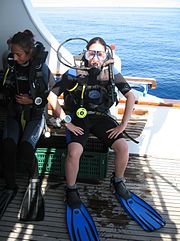
This section looks at some of the physiological issues posed by diving. See Diving hazards and precautions.
Breathing underwater
Water normally contains dissolved oxygen from which fish and other aquatic animals extract all their required oxygen as the water flows past their gills. Humans lack gills and do not otherwise have the capacity to breathe underwater unaided by external devices.
Early diving experimenters quickly discovered it is not enough simply to supply air in order to breathe comfortably underwater. As one descends, in addition to the normal atmospheric pressure, water exerts increasing pressure on the chest and lungs — approximately 1 bar or 14.7 psi for every 33 feet or 10 meters of depth — so the pressure of the inhaled breath must exactly counter the surrounding or ambient pressure in order to inflate the lungs.
By always providing the breathing gas at ambient pressure, modern demand valve regulators ensure the diver can inhale and exhale naturally and virtually effortlessly, regardless of depth.
Because the diver's nose and eyes are inside a diving mask, the diver cannot breathe in through the nose, except when wearing a full face diving mask. However, inhaling from a regulator's mouthpiece becomes second nature very quickly.
The most commonly used scuba set today is the open circuit 2-stage diving regulator, coupled to a single pressurized gas cylinder. This 2-stage arrangement differs from Emile Gagnan's and Jacques Cousteau's original 1942 design, known as the Aqua-lung, in which the cylinder's pressure was reduced to ambient pressure in a single stage. The 2-stage system has significant advantages over the original single-stage design.
In the 2-stage design, the first stage regulator reduces the cylinder pressure of about 200 bar (3000 psi) to an intermediate level of about 10 bar (145 psi). The second stage demand valve regulator, connected via a low pressure hose to the first stage, delivers the breathing gas at the correct ambient pressure to the diver's mouth and lungs. The diver's exhaled gases are exhausted directly to the environment as waste. The first stage typically has at least one outlet delivering breathing gas at unreduced tank pressure. This is connected to the diver's pressure gauge or computer, in order to show how much breathing gas remains.
For more information, see diving regulator.
Less common (but becoming increasingly available) are closed and/or semi-closed rebreathers. Open-circuit sets vent off all exhaled gases, but rebreathers reprocess each exhaled breath for re-use by removing the carbon dioxide buildup and replacing the oxygen used by the diver. Rebreathers release few or no gas bubbles into the water, and use much less oxygen per hour because exhaled oxygen is recovered; this has advantages for research, military, photography, and other applications. See frogman. Modern rebreathers (rather than old-type plain oxygen rebreathers) are more complex and more expensive than sport open-circuit scuba, and need special training and maintenance to safely use. See rebreather.
For some diving, gas mixtures other than normal atmospheric air (21% oxygen, 78% nitrogen, 1% other) can be used, so long as the diver is properly trained in their use. The most commonly used mixture is Enriched Air Nitrox, which is air with extra oxygen, often with 32% or 36% oxygen, and thus less nitrogen, reducing the effect of decompression sickness and nitrogen narcosis.
Several other common gas mixtures are in use, and all need specialized training. Oxygen with helium and a reduced percentage of nitrogen is known as trimix, for example.
In cases of technical dives more than one cylinder may be carried, each containing a different gas mixture for a distinct phase of the dive, typically designated as Travel, Bottom, and Decompression. These different gas mixtures may be used to extend bottom time, reduce inert gas narcotic effects, and reduce decompression times.
In the 2-stage design, the first stage regulator reduces the cylinder pressure of about 200 bar (3000 psi) to an intermediate level of about 10 bar (145 psi). The second stage demand valve regulator, connected via a low pressure hose to the first stage, delivers the breathing gas at the correct ambient pressure to the diver's mouth and lungs. The diver's exhaled gases are exhausted directly to the environment as waste. The first stage typically has at least one outlet delivering breathing gas at unreduced tank pressure. This is connected to the diver's pressure gauge or computer, in order to show how much breathing gas remains.
For more information, see diving regulator.
Less common (but becoming increasingly available) are closed and/or semi-closed rebreathers. Open-circuit sets vent off all exhaled gases, but rebreathers reprocess each exhaled breath for re-use by removing the carbon dioxide buildup and replacing the oxygen used by the diver. Rebreathers release few or no gas bubbles into the water, and use much less oxygen per hour because exhaled oxygen is recovered; this has advantages for research, military, photography, and other applications. See frogman. Modern rebreathers (rather than old-type plain oxygen rebreathers) are more complex and more expensive than sport open-circuit scuba, and need special training and maintenance to safely use. See rebreather.
For some diving, gas mixtures other than normal atmospheric air (21% oxygen, 78% nitrogen, 1% other) can be used, so long as the diver is properly trained in their use. The most commonly used mixture is Enriched Air Nitrox, which is air with extra oxygen, often with 32% or 36% oxygen, and thus less nitrogen, reducing the effect of decompression sickness and nitrogen narcosis.
Several other common gas mixtures are in use, and all need specialized training. Oxygen with helium and a reduced percentage of nitrogen is known as trimix, for example.
In cases of technical dives more than one cylinder may be carried, each containing a different gas mixture for a distinct phase of the dive, typically designated as Travel, Bottom, and Decompression. These different gas mixtures may be used to extend bottom time, reduce inert gas narcotic effects, and reduce decompression times.
ไม่มีความคิดเห็น:
แสดงความคิดเห็น